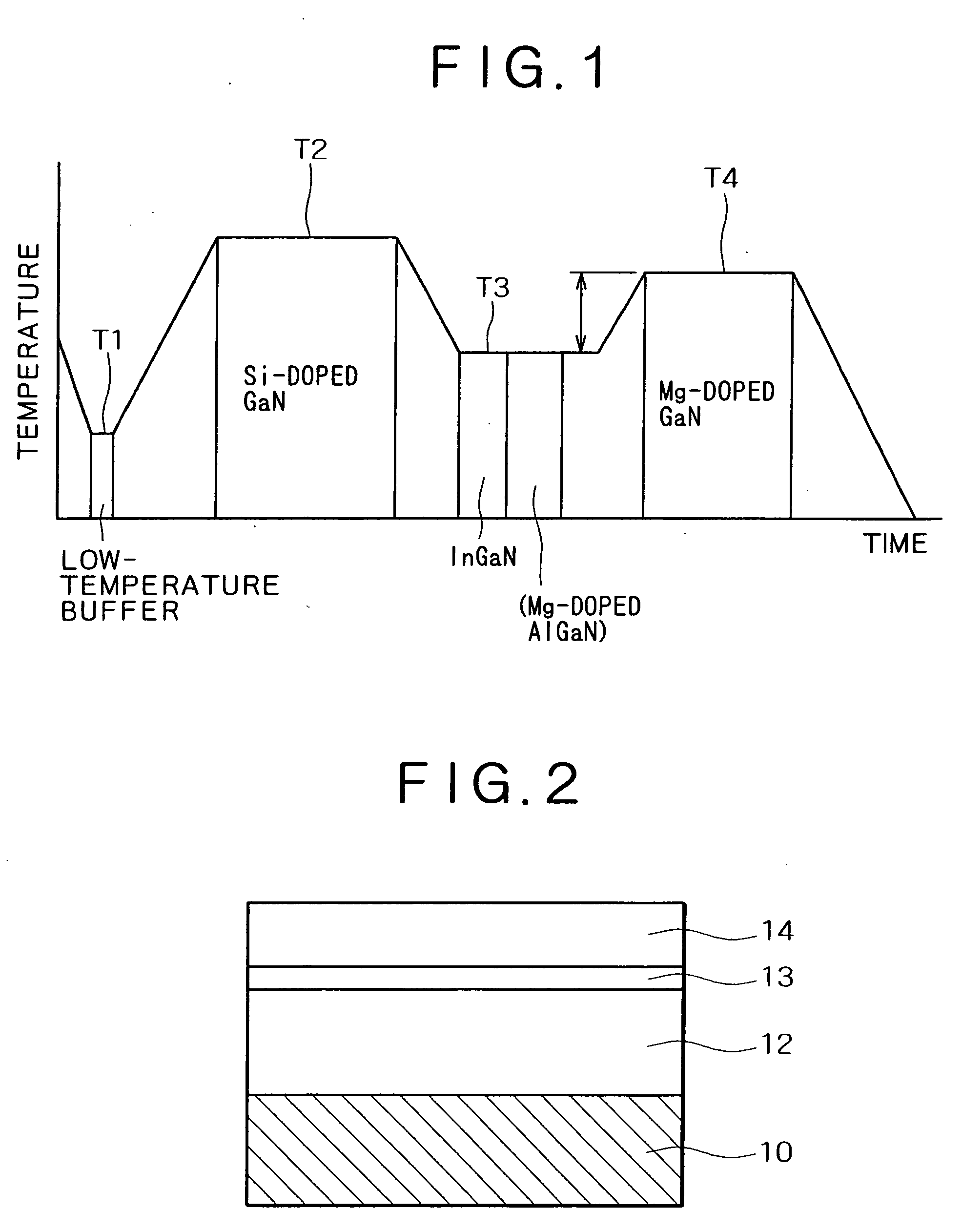Process for production of nitride semiconductor device and nitride semiconductor device
a technology of nitride semiconductor and semiconductor device, which is applied in the direction of crystal growth process, semiconductor laser, polycrystalline material growth, etc., can solve the problems of reducing the light-emitting power of the semiconductor device, the active layer, and the gainn layer at a low temperature of 700° c. to 800° c., so as to facilitate the formation of a smooth surface and low leakage current
- Summary
- Abstract
- Description
- Claims
- Application Information
AI Technical Summary
Benefits of technology
Problems solved by technology
Method used
Image
Examples
example 1
[0034] This example demonstrates the process for production of a nitride semiconductor device according to an embodiment of the present invention as shown in FIGS. 1 to 3.
[0035]FIG. 1 is a diagram showing the growth temperature which varies with time for different layers. It is noted that the initial growth temperature (T1) for the buffer layer is about 500° C. as shown in FIG. 1. The growth temperature is raised to T2 (about 1020° C.) for the silicon-doped n-type GaN layer. With the supply of trimethylgallium suspended temporarily, the growth temperature is lowered to T3 (about 730° C.). With the growth temperature kept at 730° C., an active layer of InGaN (30 angstroms (Å) thick) is grown from trimethylgallium (as a gallium source) and trimethylindium (as an indium source) after the carrier gas has been switched from a mixture to nitrogen.
[0036] After the active layer of InGaN has been formed, the magnesium-doped AlGaN layer is grown thereon at the growth temperature of T3. Subs...
example 2
[0044] This example demonstrates the process for production of a GaN-based semiconductor light-emitting device according to an embodiment of the present invention that has a similar structure as that in Example 1. This example is based on the fact that the wavelength of the light emitted from the GaN semiconductor light-emitting device varies depending on the growth temperature of the nitride semiconductor layer formed on the active layer.
[0045] Applicants have discovered through experimentation that the wavelength of the light emitted from the GaN semiconductor light-emitting device varies depending on the growth temperature of the nitride semiconductor layer formed on the active layer. Applicants conducted experiments on several kinds of GaN-based light-emitting diodes, each having the same structure as in Example 1 (or including an n-type GaN layer, an InGaN layer, and a p-type GaN layer) but differing in the growth condition for the active layer. The resulting samples were test...
example 3
[0048] This example demonstrates a GaN-based semiconductor laser in which the active layer is a compound crystal of indium. The process for its production will be explained with reference to FIGS. 6 and 7.
[0049] First, a sapphire substrate 20 (whose principal plane is c-plane) undergoes thermal cleaning at about 1050° C. in the same way as in Example 1. On the substrate is grown a GaN or AlN buffer layer at about 510° C. With the reaction temperature raised to about 1020° C., an undoped GaN layer 21 (1 micron thick) and a silicon-doped n-type GaN layer 22 (3 microns thick) are grown sequentially. Silicon is introduced in the form of silane gas.
[0050] With the Si-doped n-type GaN layer 22 formed, the reaction chamber is supplied with NH3 (as a nitrogen source), trimethylgallium (Ga(CH3)3 as a gallium source), and trimethylaluminum (Al(CH3)3 as an aluminum source), so that an n-type AlGaN cladding layer 23 is grown.
[0051] With the supply of NH3 continued but the supply of trimethyl...
PUM
 Login to View More
Login to View More Abstract
Description
Claims
Application Information
 Login to View More
Login to View More - R&D
- Intellectual Property
- Life Sciences
- Materials
- Tech Scout
- Unparalleled Data Quality
- Higher Quality Content
- 60% Fewer Hallucinations
Browse by: Latest US Patents, China's latest patents, Technical Efficacy Thesaurus, Application Domain, Technology Topic, Popular Technical Reports.
© 2025 PatSnap. All rights reserved.Legal|Privacy policy|Modern Slavery Act Transparency Statement|Sitemap|About US| Contact US: help@patsnap.com



